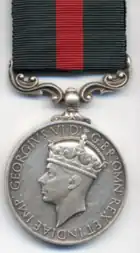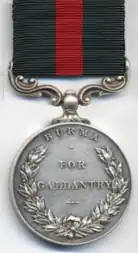| Burma Gallantry Medal | |
|---|---|
  Obverse and reverse of the medal | |
| Type | Gallantry decoration |
| Awarded for | Acts of conspicuous gallantry performed in connection with assigned duties |
| Country | British Burma |
| Presented by | the Governor General of Burma |
| Eligibility | Governor's commissioned officers, non-commissioned officers and other ranks of the armed forces of British Burma |
| Post-nominals | BGM |
| Campaign(s) | World War II |
| Status | No longer awarded |
| Established | 10 May 1940 |
| First awarded | 26 March 1942 |
| Last awarded | 28 November 1947 |
| Total | 207 and 3 clasps |
Ribbon bar | |
The Burma Gallantry Medal (BGM) was a military decoration awarded for acts of gallantry, in both war and peace, by Governor's commissioned officers, non-commissioned Officers and other ranks of the British Burmese military. These included its Army, Frontier Force, Military Police, Royal Naval Volunteer Reserve and Auxiliary Air Force.[1] Clasps, attached to the ribbon, could be awarded to mark further awards of the medal.[2]
When Burma ceased to be a province of British India in 1937 and became a separate colony, a distinct gallantry medal was required for its armed forces.[3] In response, the Burma Gallantry Medal was established by royal warrant on 10 May 1940.[1]
Between 26 March 1942 and 28 November 1947, a total of 207 medals and 3 clasps were awarded. In addition to the medal, recipients were entitled to a monthly monetary allowance, paid for life.[4]
The medal became obsolete when Burma gained independence on 4 January 1948.[4]
Appearance
The medal 36 mm in diameter, is circular and made of silver. The obverse bears the crowned effigy of King George VI facing left with the inscription GEORGIVS VI D:G:BR:OMN:REX ET INDIAE:IMP. The reverse bears a laurel wreath and the inscription "Burma" and "For Gallantry". The medal is suspended from a dark green ribbon with a crimson central stripe.[1]
The recipient's name, rank and unit were engraved on the rim of the medal.[4]
References
- 1 2 3 "Royal Warrant for the Burma Gallantry Medal" (PDF). The Edinburgh Gazette. September 7, 1945. Archived from the original (PDF) on 23 May 2012. Retrieved 30 October 2011.
- ↑ Captain H. Taprell Dorling. (1956). Ribbons and Medals. A.H.Baldwin & Sons, London. p. 48.
- ↑ Mussell, John, ed. (2014). Medal Yearbook 2015. Token Publishing Ltd, Devon, UK. p. 97. ISBN 9781908828316.
- 1 2 3 Abbott, Peter; Tamplin, John (1981). British Gallantry Awards (2nd ed.). Nimrod Dix and Co, London. pp. 31–34. ISBN 9780902633742.